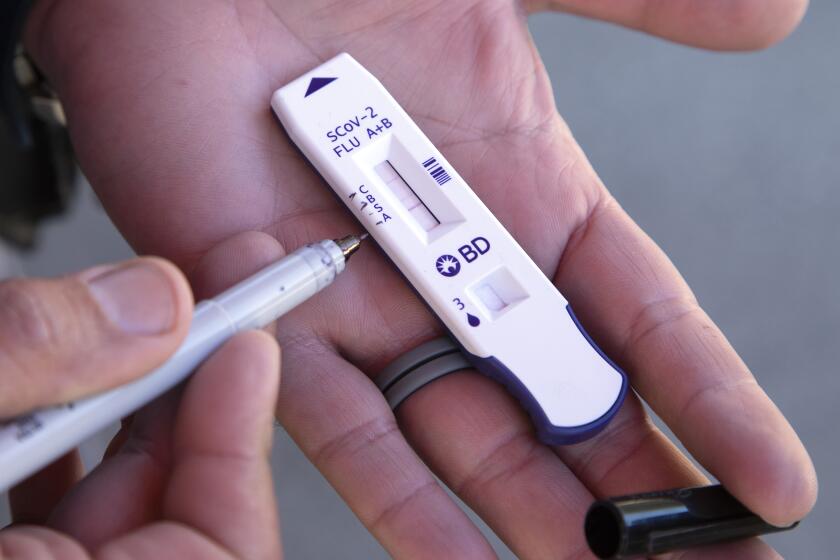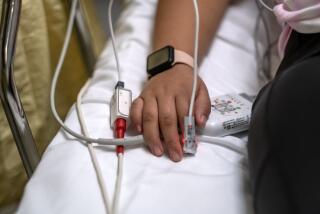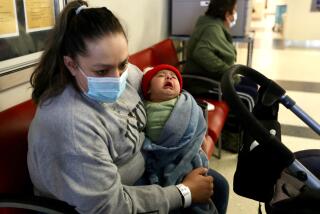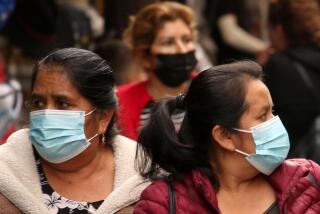L.A. County sees a record 44,000 new coronavirus cases as staff shortages strain hospitals
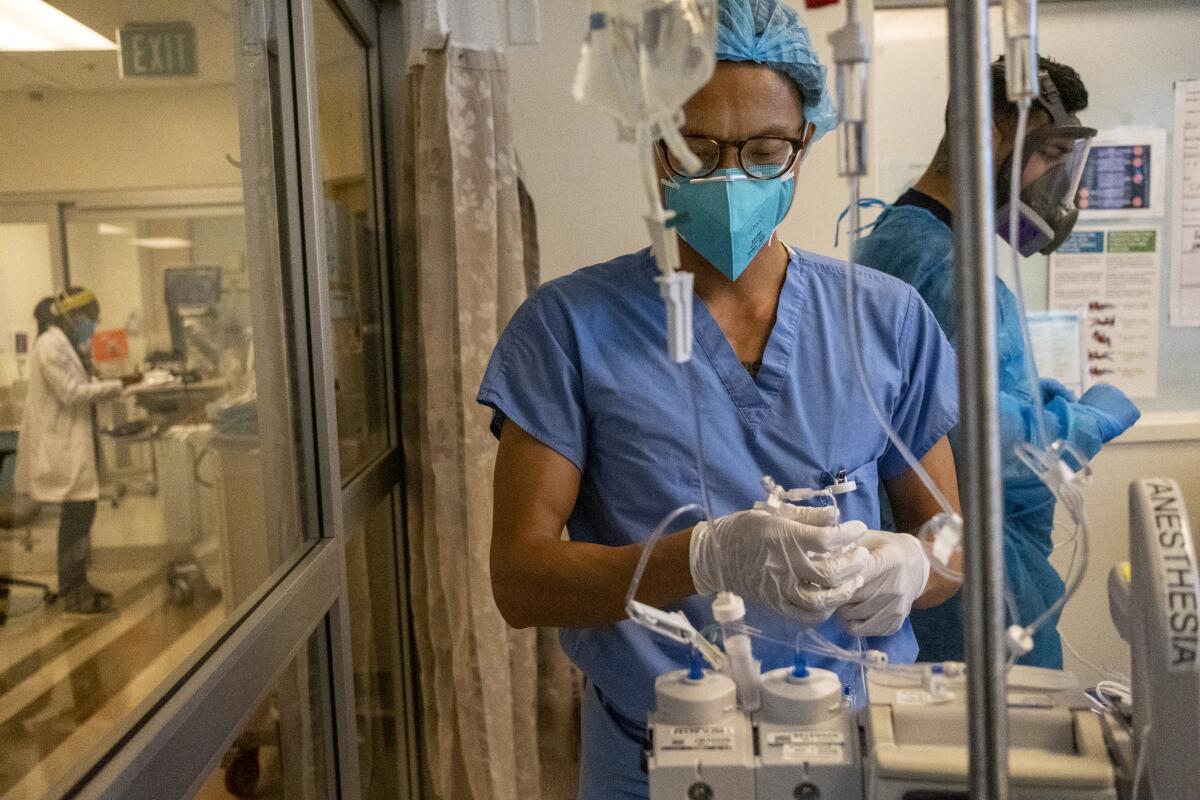
- Share via
Emergency rooms across California are coming under strain as they contend both with a deluge of new coronavirus-positive patients and people coming in to demand tests — all as their workers are increasingly being stricken by the rapidly spreading Omicron variant.
In Los Angeles County, officials said the healthcare system is experiencing significant workforce shortages because of rampant coronavirus transmission.
Over the week ending Thursday, 973 new coronavirus cases were reported among healthcare workers, according to the county Department of Public Health, up 47% from the previous week.
Overall, L.A. County reported 43,712 new coronavirus cases on Friday alone — the highest single-day total of the pandemic. The previous record, 37,215, came Thursday. Those numbers are well above the average daily peak last winter, when L.A. County was recording about 16,000 new coronavirus cases a day.
The surge in cases has brought along a surge in demand for coronavirus testing, overwhelming hospitals and other sites.
Gov. Gavin Newsom announced Friday that National Guard troops would be deployed throughout the state to help with testing.
“The National Guard plan will deploy over 200 Cal Guard members across 50 Optum Serve sites around the state, providing interim clinical staff while permanent staff are hired, adding capacity for walk-ins, assisting with crowd control and back-filling for staff absences — all in an effort to conduct more tests for more Californians. Additional members of the Guard will be deployed next week in similar capacities,” the governor’s office said in a statement.
In Orange County, about five of its 25 hospitals are asking for more staffing from the state “because they are experiencing extreme staffing shortages,” and more requests are expected, said Dr. Regina Chinsio-Kwong, a deputy county health officer.
“Our hospitals are full, and the emergency departments are really getting hit hard,” she said Friday.
Emergency rooms have a limited number of beds and staff to work with. Chinsio-Kwong said that, anecdotally, she’s heard anywhere from 10% to 20% of workers are unavailable due to coronavirus-related reasons, calling it a “dire situation.”
Ambulances are waiting as long as 52 minutes at hospitals to drop off patients, well above the 30-minute goal, Chinsio-Kwong said, most hospitals have set up surge tents to increase capacity, and Orange County has stopped accepting hospital patients diverted from neighboring counties.
It’s possible that hospitals in Orange County will have to start suspending scheduled surgeries, as has already occurred elsewhere in California, including L.A. County.
So far, however, hospitals are not seeing a critical shortage of available intensive care unit beds, Chinsio-Kwong said.
Many counties are seeing a growing percentage of people entering hospitals with a coronavirus infection but being treated for something other than COVID-19.
“This is very different than what we were experiencing a year ago,” Dr. Brad Spellberg, chief medical officer at Los Angeles County-USC Medical Center, said Friday. “Clearly, the number of positive tests is actually higher than it was a year ago — and I understand why that’s very scary, in terms of these numbers going up — but the average sickness level is substantially lower.”
During the last winter surge, about 80% of coronavirus-positive patients in the flagship public hospital’s emergency department were being admitted to the hospital, and nearly half of those went to the ICU, Spellberg said. Now, only about a third of coronavirus-positive patients are admitted and about 20% to 25% of those are going to the ICU.
“That gives you a sense of the difference in magnitude,” he said. “This is why last year was much more stressful in many ways. We did come within a hair’s breadth of triaging patients last year.”
That doesn’t mean the hospital is not seeing terribly sick patients or that patients aren’t on ventilators and dying of COVID-19, he added. Nearly all of those patients are unvaccinated.
L.A. County hospitals are seeing far fewer critically ill coronavirus-positive patients than they did last winter, despite a spike in Omicron cases.
But while some circumstances have improved, not everything is easier. The highly transmissible nature of the Omicron variant is contributing to staffing challenges as it sweeps through the workforce affecting many who are not seriously ill but must quarantine at home, Spellberg said. And many healthcare workers across the country have quit, retired or burned out.
“We’re tight in the hospital not so much because of a flood of patients but because we have patients coming in and a bunch of beds closed,” he said.
However, because most patients — particularly vaccinated patients — are less sick, the hospital is able to turn the beds over much faster.
The emergency room at Kaiser Permanente’s Downey Medical Center has been overloaded with patients seeking care for the flu and COVID-19, officials said this week. The hospital has been “on and off diversion” for the last 48 hours, said Kaiser Permanente Southern California spokeswoman Jennifer Maravillas.
“Diversion is only done when it is absolutely necessary whether it is done for just a few hours or a full day,” she said. But “it is possible this method of managing the number of patients who need care will continue during the peak of this surge.”
The tactic is being considered at other Kaiser hospitals in California, she said, although she would not specify which ones.
Kaiser is managing staffing by employing traveling nurses, adjusting elective and nonurgent surgeries and procedures, and making use of telehealth options.
In Arcadia, more than 100 employees at Methodist Hospital of Southern California are unable to come to work because of coronavirus infections, including roughly 50 nurses, said Clifford R. Daniels, its senior vice president and chief strategy officer.
In a hospital with fewer than 350 beds, “that’s a lot of nurses,” Daniels said. “And it’s putting a burden on us in trying to staff units to take care of patients.”
So far, the Omicron surge has not sent nearly as many patients to the Arcadia hospital as last year: Daniels said the hospital had roughly 40 patients Friday who had tested positive for the coronavirus, less than a third of the number during the devastating surge a year ago.
But with so many nurses out, emergency room waits are longer and, at one point, “extraordinary numbers of ambulances” were lined up outside waiting to unload, Daniels said.
To cope, Methodist Hospital will delay elective procedures that were scheduled for next week.
The hospital is also urging people who have no symptoms but are seeking coronavirus testing not to turn to its emergency room, echoing a plea from public health officials throughout California.
In Orange County, Chinsio-Kwong said, many people coming in seeking tests will be turned away after saying they have no symptoms. “And then usually those same patients will come back and say, ‘Oh, wait a minute, I do have a symptom,’ ” she said.
“It’s unfortunate, because the urgent cares and the ERs are so bombarded,” Chinsio-Kwong said. “It’s reducing access to care for people who actually need to be seen.”
The U.S. Centers for Disease Control and Prevention said the following symptoms are emergency warning signs of COVID-19 and warrant immediate medical care: trouble breathing; persistent pain or pressure in the chest; new confusion; inability to wake or stay awake; and pale, gray, or blue-colored skin, lips or nails. The CDC suggests calling a medical provider for other symptoms that are severe or concerning.
The winter is already a challenging time for hospitals, Chinsio-Kwong said, notable for increased mental health issues; cardiovascular conditions, such as stroke, heart attack and worsening heart failure; and respiratory conditions, such as pneumonia associated with flu or other viral illnesses.
Those who have COVID-19 symptoms but cannot get a test are urged to follow the California Department of Public Health’s guidelines: isolate at home for at least five days after symptoms begin, ending once you get a rapid negative test result, or after the 10th day if you’re still unable to get a test.
People who are exposed to someone who tests positive for the coronavirus are subject to quarantine orders if they’re not up to date on their booster or vaccination shots, and need to stay at home for at least 5 days following the exposure. They can leave as early as the sixth day if they get a negative rapid test, or after the 10th day if they’re unable to test.
There is some evidence for optimism, including the way recent spikes in South Africa and the U.K. turned around fairly quickly.
“It’s not crazy to think that something similar may happen here,” Spellberg said. “The number of people now who have been infected, combined with the number of people, at least in Southern California, who have been vaccinated, certainly offers some hope that we may be closer to the end than to the beginning at this point.”
More to Read
Sign up for Essential California
The most important California stories and recommendations in your inbox every morning.
You may occasionally receive promotional content from the Los Angeles Times.
